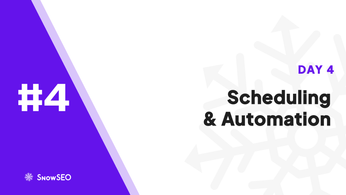
5 Competitor Analysis Tips to Outsmart Rivals
Table of Contents
Outsmarting your competition isn’t just a goal anymore - it’s essential for survival. Many businesses fail to evolve due to ineffective competitor analysis, missing crucial opportunities for growth. Arm yourself with five actionable tips to analyze and outsmart your competitors effectively. Leverage insights from industry experts and proven techniques, as research highlights that strategic competitor analysis directly influences business success and market positioning as explained by Wikipedia.
Understanding the Basics of Competitor Analysis
Competitor analysis is a strategic approach that involves evaluating the strengths and weaknesses of current and potential competitors. This process is essential for businesses aiming to identify opportunities and threats within their market, thereby informing strategic planning and decision-making.
Key Steps in Competitor Analysis
- Identify Competitors: Determine both direct and indirect competitors. Direct competitors offer similar products or services, while indirect competitors provide alternative solutions that fulfill the same customer needs.
- Analyze Competitor Offerings: Examine the products or services competitors provide, focusing on features, quality, pricing, and customer feedback. This helps in understanding their value propositions and market positioning.
- Assess Market Position: Evaluate competitors’ market share, target demographics, and geographic reach. This assessment provides insights into their customer base and market influence.
- Evaluate Marketing Strategies: Review competitors’ advertising channels, promotional tactics, and branding efforts. Understanding their marketing approaches can reveal effective strategies and potential areas for differentiation.
- Analyze Financial Performance: For publicly available data, assess competitors’ financial health, including revenue, profitability, and growth trends. This information can indicate their stability and investment capabilities.
- Monitor Technological Advancements: Stay informed about competitors’ technological innovations and adoption of new technologies. This can highlight areas where they may have a competitive edge or where your business can innovate.
- Understand Customer Perceptions: Gather insights from customer reviews, testimonials, and social media interactions related to competitors. This helps in identifying their strengths and areas where they may be underperforming.
Regularly updating competitor analysis ensures that businesses remain responsive to market changes and maintain a competitive advantage.
Essential Tools for Competitor Analysis
Utilizing specialized tools can streamline the competitor analysis process and provide comprehensive insights:
- Ahrefs: A robust tool for analyzing competitors’ backlink profiles, keyword rankings, and overall SEO performance.
- SEMrush: Offers insights into competitors’ online visibility, including organic and paid search data, backlink analysis, and advertising strategies.
- SimilarWeb: Provides data on competitors’ website traffic, audience demographics, and engagement metrics, aiding in understanding their online presence.
Incorporating these tools into your competitor analysis can enhance the depth and accuracy of the insights gathered, facilitating more informed strategic decisions.

Advanced Techniques for Competitive Edge
In today’s rapidly evolving market, staying ahead of competitors requires more than just traditional strategies. Advanced techniques like predictive analysis and the effective implementation of competitive insights are essential for businesses aiming to outsmart their rivals.
Predictive Analysis and Market Trends
Predictive analysis involves using historical data, statistical algorithms, and machine learning techniques to identify the likelihood of future outcomes. By analyzing patterns and trends, businesses can anticipate market changes and consumer behaviors, allowing them to make proactive decisions.
For instance, during the COVID-19 pandemic, predictive models were instrumental in forecasting disease spread and informing public health responses. The Centers for Disease Control and Prevention (CDC) utilized such models to estimate epidemic trends, demonstrating the power of predictive analytics in dynamic environments. (cdc.gov)
In the business realm, predictive analytics can be applied to:
- Demand Forecasting: Anticipating product demand to optimize inventory and supply chain management.
- Customer Behavior Analysis: Identifying purchasing patterns to tailor marketing strategies.
- Risk Management: Assessing potential risks to develop mitigation plans.
By leveraging predictive analysis, companies can stay ahead of market trends and make informed strategic decisions.
Implementing Competitive Insights
Gathering competitive intelligence is only the first step; effectively implementing these insights is crucial for gaining a competitive edge. This process involves analyzing competitors’ strategies, strengths, and weaknesses to inform one’s own business decisions.
A study published in the Frontiers in Public Health highlighted the importance of accurate predictive modeling in public health interventions. The research emphasized that while numerous models exist, their effectiveness depends on proper implementation and continuous evaluation. (pmc.ncbi.nlm.nih.gov)
In a business context, implementing competitive insights can involve:
- Benchmarking: Comparing performance metrics against competitors to identify areas for improvement.
- Strategic Planning: Developing business strategies that capitalize on competitors’ weaknesses and market opportunities.
- Product Development: Innovating products or services to fill gaps in the market identified through competitive analysis.
By systematically applying competitive insights, businesses can refine their strategies and maintain a leading position in the market.
For a practical demonstration of implementing competitive insights, consider the following tutorial:
Measuring Success: KPIs and Metrics
In marketing competitor analysis, Key Performance Indicators (KPIs) are essential for evaluating success. KPIs are quantifiable measures that assess the effectiveness of an organization or specific activities, providing a basis for strategic and operational improvements. (en.wikipedia.org)
Defining and Tracking KPIs
Effective KPIs should be specific, measurable, achievable, relevant, and time-bound (SMART). They can be categorized into:
- Quantitative KPIs: Numerical data, such as market share percentage.
- Qualitative KPIs: Non-numeric data, like customer satisfaction levels.
Selecting appropriate KPIs involves understanding organizational goals and ensuring the indicators align with these objectives. For instance, a company might track customer acquisition cost to evaluate marketing efficiency. (en.wikipedia.org)
Regular monitoring and analysis of these KPIs enable businesses to identify strengths, weaknesses, and areas for improvement, ensuring they remain competitive in the market.

Common Pitfalls in Competitor Analysis
Conducting competitor analysis is essential for strategic planning, yet several common pitfalls can undermine its effectiveness. Recognizing and avoiding these errors is crucial for obtaining accurate insights.
1. Avoiding Data Misinterpretation
Misinterpreting data can lead to flawed strategies. For instance, failing to account for confounding variables may result in incorrect conclusions about competitors’ performance. It’s vital to ensure that data collection methods are robust and that analyses consider all relevant factors to avoid such biases. (ncbi.nlm.nih.gov)
2. Overlooking Indirect Competitors
Focusing solely on direct competitors can cause businesses to miss threats from indirect competitors offering substitute products or services. A comprehensive analysis should include all potential market players to fully understand the competitive landscape. (sba.gov)
3. Neglecting Market Trends
Ignoring broader market trends can render competitor analysis obsolete. Staying informed about industry developments ensures that strategies remain relevant and responsive to changing market conditions.
4. Relying on Outdated Information
Using outdated data can lead to misinformed decisions. Regularly updating competitor analysis with current information is essential for maintaining a competitive edge.
5. Failing to Identify Competitor Strengths and Weaknesses
An incomplete assessment of competitors’ strengths and weaknesses can result in missed opportunities or unexpected challenges. A thorough evaluation provides a clearer picture of the competitive environment.
By being aware of these pitfalls and implementing effective competitor analysis tips, businesses can develop more accurate and actionable strategies.
Ready to outsmart your competitors? Start implementing a smarter competitor analysis today with the tools and tips provided. Discover how SnowSEO automates competitor monitoring, content optimization, and AI-driven insights at snowseo.com for faster, data-driven growth.
Frequently Asked Questions
Q1: How often should I conduct competitor analysis for my business?
It’s best to review your competitors at least quarterly, but fast-moving industries may require monthly check-ins. Regular analysis helps you stay ahead of market shifts, spot new entrants, and quickly adapt your strategies. If you’re launching a new product or entering a new market, a fresh competitor review is essential to avoid surprises and capitalize on opportunities.
Q2: What tools are most effective for competitor analysis?
Top tools include Ahrefs, SEMrush, and SimilarWeb. These platforms offer insights into competitors’ website traffic, keyword strategies, and backlink profiles. Combining data from multiple sources gives a fuller picture, letting you benchmark performance and uncover gaps in your own approach.
Q3: Can small businesses benefit from competitor analysis?
Absolutely. Even with limited resources, small businesses can gain valuable insights by monitoring competitors’ pricing, promotions, and customer feedback. This information helps refine your offerings and spot trends early, giving you a strategic edge.
Conclusion
Mastering competitor analysis means understanding essential steps, leveraging advanced techniques for deeper insights, and tracking progress with the right KPIs. Begin integrating these strategies into your business planning now. Research highlights that structured competitor analysis significantly boosts market performance as detailed by Investopedia, driving smarter, data-driven decisions.





